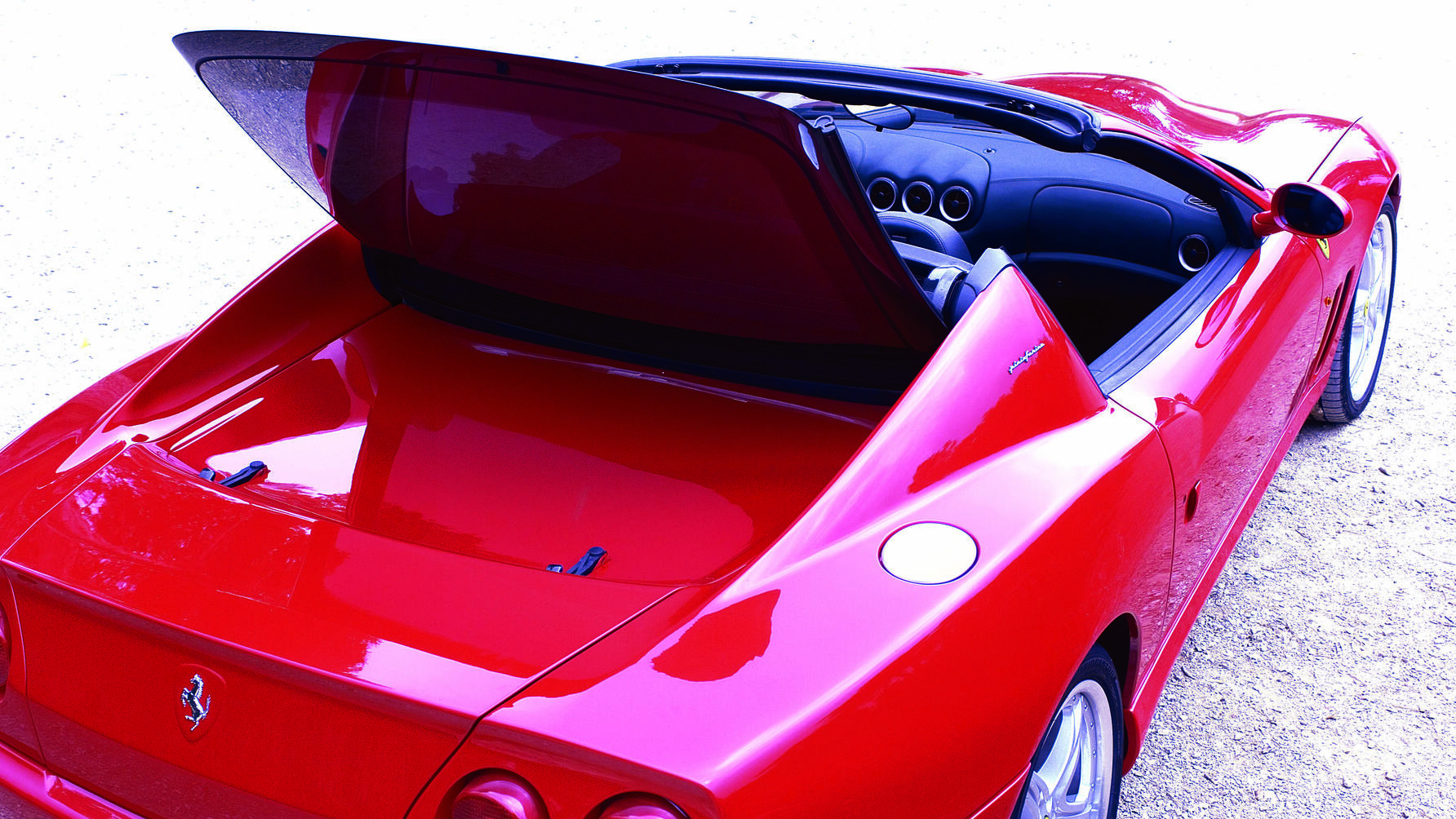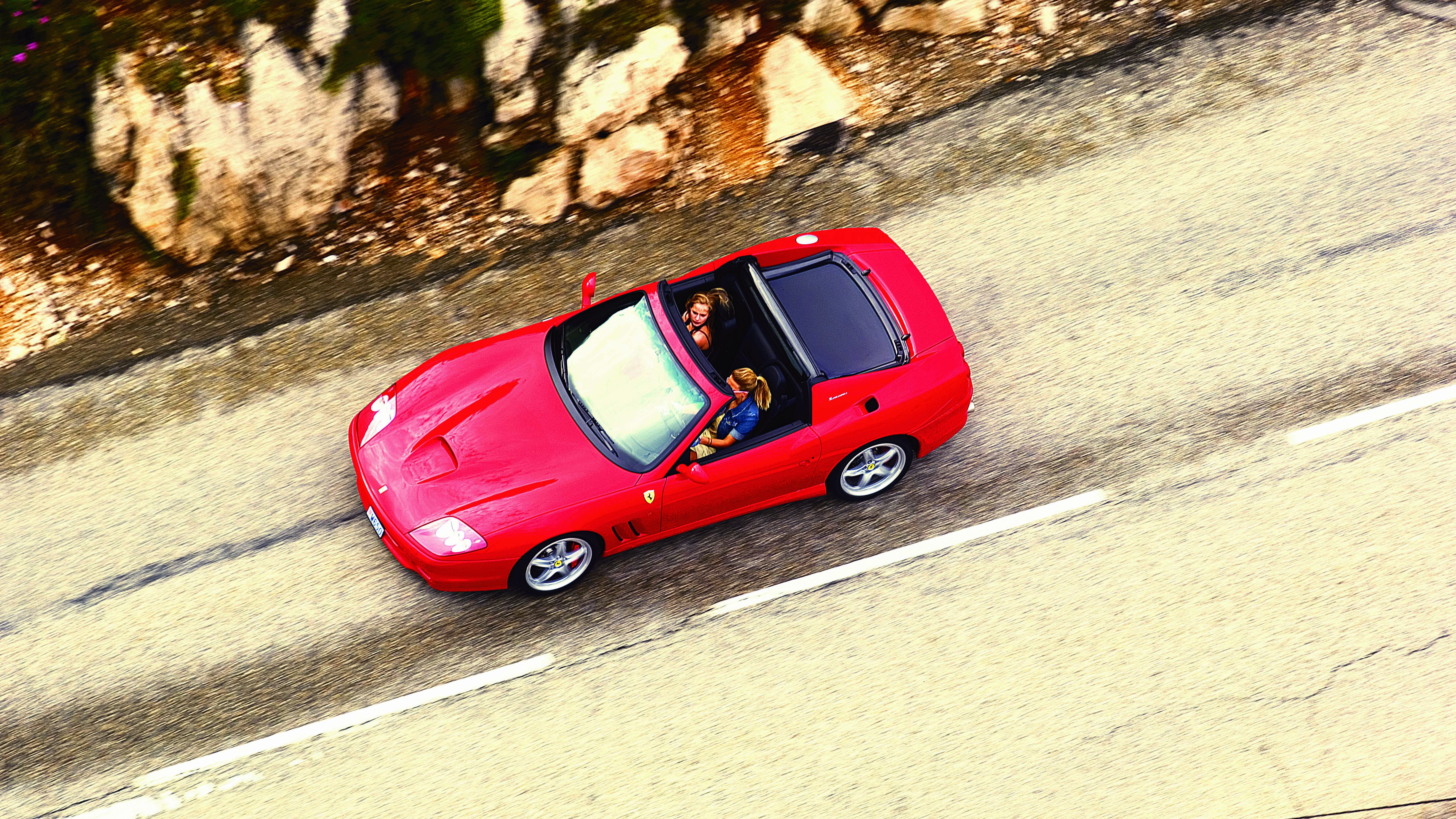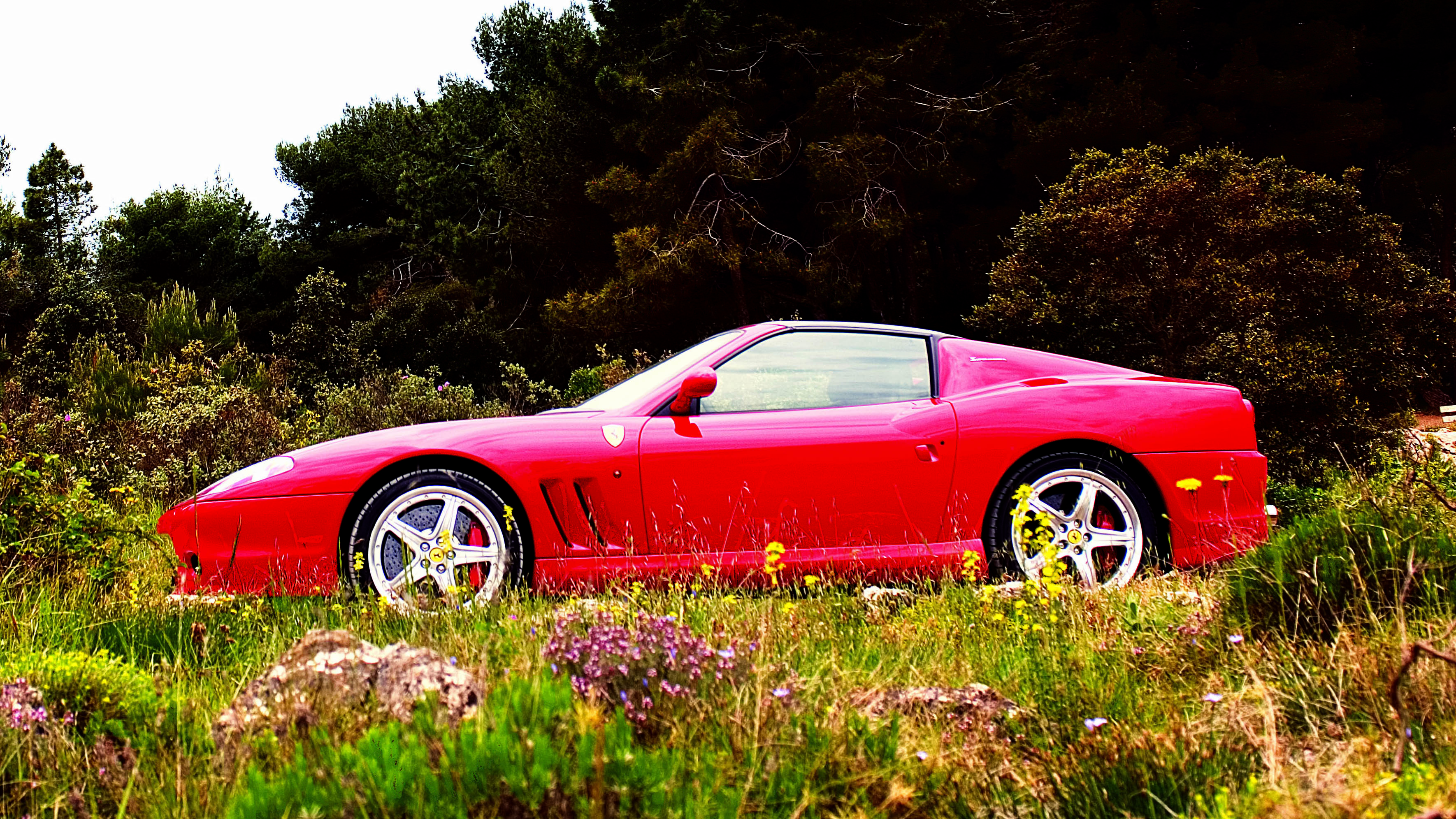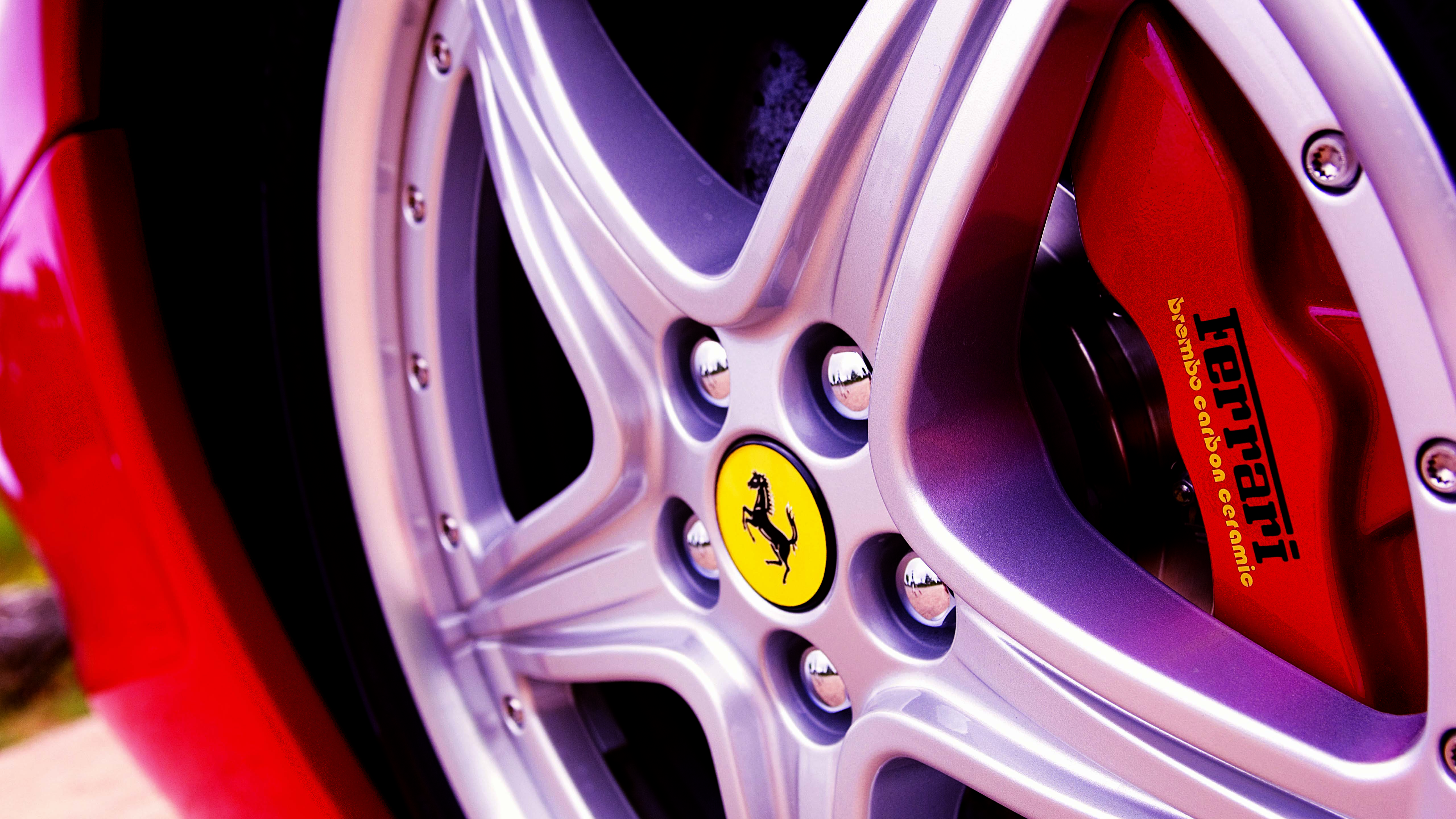
From the archives: the Ferrari 575 Superamerica
A throwback to 2005 and our first drive of Ferrari’s flip-top, V12-engined 575
It’s an old car now, the Ferrari Maranello. Oldest of the front-line supercars by a long chalk. I remember the launch, in 1994. Michael Schumacher drove me around the Nürburgring Grand Prix circuit in one. He’ll have absolutely no reason to remember me, except possibly as the hack who asked him the most inane questions he’s ever been asked in all his life of answering inane questions – I mean, how do you turn what he does into words? But when I finally overcame my embarrassment and played back the tape I noticed that he had the tyres squealing for five-and-a-half seconds as he rounded the hairpin onto the pit straight. And I know for a fact that was almost entirely full opposite lock. Pause, gentle reader, gaze at the second hand on your watch, and re-enact such a drift in your mind. Genius. Anyway, back to age. We went on to test the 550 Maranello against tackle that now seems ancient history: the Aston Virage Vantage, Lamborghini Diablo and Porsche 993 Turbo. That’s an air-cooled one, Daddio.
This feature was first published in Issue 142 of Top Gear magazine (2005)
Images: Tom Salt
And yet just six months ago I had a proper go in the 575 Maranello outfitted with the GTC handling pack, and it still felt like a brand-new car: the outrageous speed of it, the precision, the balance and grip and brakes when you were going flat-out and yet it was a brilliant cruiser too. And it felt totally solid and utterly impregnable. What a lifespan.
But going topless in old age is always a risk. Unless you’re like that old geezer who swam out beyond the harbour around a buoy and back while they poured his Guinness, stripping off beyond middle age is fraught with difficulties. You are parading your body’s every time-addled defect for all to see. And it’s just the same with cars. Going topless rudely exposes any defects in the underlying structure. Still, if any car can get away with it, this perma-youthful Ferrari has got to be the one that can.
So, with just over a year of production left to go, the Maranello has spawned the Superamerica. It’s a coupe-cabriolet, but not as we know it. Ferrari sentimentalists like I am were delighted to learn the roof was the invention of Leonardo Fioravanti. In the pantheon of artistic Leos, Fioravanti sits a long way above DiCaprio and only a smidge behind da Vinci: he worked for Pininfarina in the 1960s and did the Dino, Daytona, Boxer, 308GTB and 288GTO. Gulp.

There’s really only one moving part, a giant carbon frame with two pieces of glass, one for the roof and one for the rear window, set into it. In cross-section, this assembly is the shape of a walking stick. The semicircular bit is the back window, the straight bit the roof. It pivots around an axis running through the notional centre of the semicircle. So when it’s up, the back window bows outward (which looks a bit odd to be honest, like some bit of Fifities Detroit over-design), and when it’s down the rear glass becomes concave – what was the inner surface is now the outer.
It really is a nifty bit of roofery. For a start it’s quick: from closed, all you do is swing a central spade handle to unlock it and touch a switch. It rears up and swings back, quietly clamping itself onto the boot lid. To close, simply press the switch again and it happens so fast it’s almost scary, like a giant crocodile jaw snapping shut on you. I involuntarily (and unnecessarily) ducked every time. The speed comes from its simplicity, a different world from the Byzantine geometries of conventional coupe-cabrio tops. Open, closed or in the movements between, the whole of it snuggles neatly above the car. So you get all the boot space and fuel tank size of the regular 575. What’s really neat, the boot lid itself is hinged coaxially with the roof panel, so that you can open the boot lid when the roof ’s down and the two don’t foul each other.
It has another trick. The main glass panel is electrochromic (hence the name Revocromico): by applying a tiny current it can go from merely tinted to pretty well opaque. A rotary switch on the console does the job. So even if it’s a cold wintry day, you can simulate the visual effect of openness while keeping a glass barrier between you and the falling leaves, rain and bombing pigeons. In summer if you don’t want to be open, just flick the switch to dark and you’ve cut the greenhouse heat-gain.
’Course, it’s not perfect. If you get caught in the rain and can’t stop to swing the roof, water collects in a puddle and lands on your head when you do put it up. The shape of the fixed rear pillars makes some turbulence too. Which adds noise. But nothing to cry about. Oh, and it sucks the top speed back: despite having extra power over the 575, this car won’t crack a test-track 200mph. To make it easy to remember, the 199mph top speed exactly matches the £199,000 price tag for the version that will take the most sales, the one with the Formula One-style paddle-shift gearbox. Oh yes.
As I said, the roof isn’t the most beautiful thing in the world when it’s up, but the rest of the car still looks just fine. When it was new, the world (me included) decreed the Ferrari 550’s shape was awkward and graceless. We were all wrong. Barely changed as the 575, nine years on it has worn well: the rest of the design world has caught up with Pininfarina’s thinking. No, it isn’t beautiful, but it’s dramatic and serious. And modern. Yet another reason to suppose this is the one car in the world that can cope with a late-life bout of toplessness. The interior doesn’t make you fold yourself up to get in and out, and it looks classic, well able to cope with its new-found exposure to bystanders. All tan leather and stitching, like being inside an Italian driving loafer.
Ferrari has done some wide-ranging strengthening to the lower body to make up for the lost fixed metal overhead. That adds weight of course, a total of 60kg with the moving roof as well. But never fear, another 25bhp has been added to compensate. Five per cent more power for three-and-a-half per cent more weight, as that bloke on the radio cricket with the statistics and the listeners’ cakes might point out. Yup, the Superamerica has 540 horses, same as the 612 Scaglietti. In performance there’s no difference worth talking about between the SA and the 575 – both bang off the 0-62mph sprint in 4.2 seconds which is championship stuff for front-engined cars.
Top Gear
Newsletter
Thank you for subscribing to our newsletter. Look out for your regular round-up of news, reviews and offers in your inbox.
Get all the latest news, reviews and exclusives, direct to your inbox.
But the fact that the new car’s power comes right at the top end may account for the fact that I kept banging my head on the rev limiter. This engine is just so smooth and keen to spin to dizzying heights that there seems no reason not to wind it clear off the clock. But at 7,500 it calls a halt. Such perfect engineering means it’s almost too quiet as well. Why can’t Ferrari get the wonderful mid-range holler of the Aston V12? Even at full revs I want to hear more. And you do hear more with the roof up, oddly. Roof down, it disappears in the wind rush – at least unless you’ve taken measures, like driving through a tunnel.
Ah, but the performance. Using the paddle shift, you can switch in the blink of an eye from a relaxed and torquey mode in the top three gears to something not far off violence in the low ratios. This isn’t beyond-control violence, because the throttle pedal is so long and precise, but it’s not far off beyond-understanding violence. There’s superb traction, too, even more than a 305/30 19 tyre would lead you to expect, so the relatively rear-biased weight distribution is having its effect.
The test car had the optional GTC handling pack (just like that coupe I was talking about, the one that trounced Aston’s Vanquish S). Part of the pack – which costs Golf GTI money so you’d want something very special – is a set of Brembo carbon-ceramic discs. Get beyond their slightly dead pedal feel and there’s stopping power that pulls the tears from your eyes.
And yet it wasn’t, on this car, as amazing as it was on that coupe. The difference is probably the tyres: the 575 Maranello GTC had Pirelli P Zero Corsa chewing-gum rubber that seemed hardly likely to last beyond the next village, but gave shattering grip during its short glorious life. The Bridgestone stuff here rides noticeably more comfortably but, though it pains me to say it, whether it’s down to the tyres or (more likely) the slight body flex, the handling has lost its teeth. Oh there’s still terrific control and balance. The car does what you tell it, even when you make entirely unreasonable demands of it. It’s still, in other words, a really, really good car to drive fast.
But not, not quite any more, a great one. It’s like your arm’s had a dentist’s injection a few hours ago and it’s not quite worn off yet. Compared with the hard-top, the steering has gone a bit numb. You trust it with your mind, not with your heart and soul. It doesn’t respond as razor-exactly either. And putting the roof up isn’t enough to bring the magic back, even with the adaptive dampers in Sport. Then there are the shimmies through the bodywork. The wibbles of the steering column. The chirrups of different bits of the interior fretting against each other. It doesn’t affect your comfort, but it does make the car feel well, a bit tired. Especially alongside the near-matchless integrity and precision of every other Ferrari the company has on the market today.
The name Superamerica isn’t meaningless. Most will go to America, which is Ferrari’s biggest market anyway. And they did lavish GTs with the same name in the Fifties and Sixties. It’s a 559-off limited edition – they like to top-end their editions with a 9 over
at Ferrari; it hangs with the claim that they always make one less than they could sell. They reckoned with this one – having shown it to some ‘special friends’ – that they’d get more than 550 orders but fewer than 600.
I can imagine driving the Superamerica over there. It’s a very good cruiser, doubtless handy for taking the golf clubs from Beverley Hills up to Palm Springs... though if I had liquidity of that magnitude, that’s probably the last lifestyle on earth I’d choose. Nonetheless, this car certainly is a fine pose if that’s what floats your boat, and it’s secure with the roof up. Plus, like any of the Maranello line, you can imagine using it every day.
This roof will surely find its rightful home one day, but it will be on a car that has been properly designed under it, and not one that’s been adapted. The Superamerica’s a sensational convertible, but not a great sports car like the 575 is. Which means today I feel a bit sad. The 575 has done the strip too late in life. It’s swum back to the quayside only to find they’ve already finished pulling its pint.











